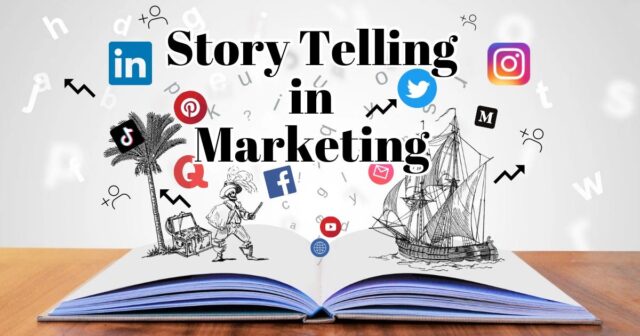In a world overflowing with information, capturing your audience’s attention is more challenging than ever. One powerful way to connect with customers and stand out from the competition is through storytelling. Stories resonate with people, evoke emotions, and create memorable experiences. In this blog, we’ll explore how to effectively use storytelling in marketing to engage your audience and drive results.

Table of Contents
Toggle1. Understand the Power of Storytelling
Storytelling has been a fundamental part of human communication for centuries. It taps into our emotions and helps us relate to experiences beyond our own. Here’s why storytelling is crucial in marketing:
- Emotional Connection: Stories evoke feelings, whether happiness, nostalgia, or empathy. This emotional connection can lead to increased brand loyalty and customer engagement.
- Memorability: People are more likely to remember stories than facts or figures. A well-crafted story can stick in the minds of your audience, making your brand more memorable.
- Relatability: Storytelling allows you to present your brand in a relatable manner. When customers see themselves in your story, they’re more likely to engage with your brand.
2. Define Your Brand’s Core Message
Before diving into storytelling, it’s essential to identify your brand’s core message. This message will serve as the foundation for all your storytelling efforts. Here are some steps to define your core message:
- Identify Your Values: What principles guide your brand? Consider your mission, vision, and values to understand what you stand for.
- Know Your Audience: Understand your target audience’s demographics, preferences, and pain points. This knowledge will help you craft stories that resonate with them.
- Craft a Unique Value Proposition (UVP): Define what makes your brand unique and why customers should choose you over competitors. Your UVP will play a significant role in your storytelling.
3. Create Compelling Characters
Characters are the heart of any good story. They help to humanize your brand and create emotional connections with your audience. Consider these tips when creating characters for your marketing stories:
- Relatable Protagonists: Create characters that your audience can relate to. This could be a customer who has faced challenges similar to those of your target audience.
- Authenticity: Ensure your characters are authentic and believable. This will help build trust and credibility with your audience.
- Character Development: Show how your characters evolve throughout the story. This development can mirror the journey your customers will take with your brand.
4. Structure Your Story Effectively
A well-structured story captivates your audience and keeps them engaged. Follow this classic story structure:
- Beginning: Introduce the setting and characters. Present the main challenge or conflict that needs to be resolved.
- Middle: Develop the narrative by showcasing the characters’ journey. Highlight their struggles, emotions, and the turning points that lead to resolution.
- End: Conclude the story by resolving the conflict and demonstrating the positive outcome. This is where you can showcase how your product or service played a role in this transformation.
5. Use Emotion to Your Advantage
Emotions play a crucial role in effective storytelling. Here’s how to evoke emotions in your marketing stories:
- Tap into Universal Themes: Themes like love, perseverance, and triumph over adversity resonate with a wide audience. Incorporate these themes to create relatable stories.
- Use Sensory Language: Engage your audience’s senses by using descriptive language that paints a vivid picture. This can help readers feel immersed in your story.
- Highlight Real Experiences: Share real-life experiences and testimonials from customers. These authentic stories can evoke empathy and resonate deeply with your audience.
6. Integrate Your Brand Naturally
While storytelling is essential, it’s important to integrate your brand naturally into the narrative. Avoid heavy-handed promotions and focus on how your brand fits into the story. Here are some tips:
- Show, Don’t Tell: Instead of directly stating your product’s benefits, demonstrate them through the characters’ experiences. Show how your brand solves a problem or enhances their lives.
- Create a Strong Brand Presence: Ensure that your brand is woven into the story without overshadowing it. Your brand’s values and personality should shine through the characters and plot.
7. Choose the Right Medium
The medium you choose for storytelling can significantly impact its effectiveness. Consider the following options:
- Blog Posts: Use storytelling in written content to share in-depth narratives, case studies, or customer testimonials.
- Video Content: Create engaging videos that bring your stories to life. Videos allow for visual and auditory storytelling, making it easier to evoke emotions.
- Social Media: Utilize platforms like Instagram and Facebook to share bite-sized stories that engage your audience. Use visuals, captions, and stories to connect with followers.
8. Engage Your Audience
Encouraging audience engagement is crucial for the success of your storytelling efforts. Here’s how to create a two-way conversation:
- Ask Questions: Prompt your audience to share their thoughts or experiences related to your story. This can foster community and increase engagement.
- Create Interactive Content: Use polls, quizzes, or contests to encourage participation and feedback from your audience.
- Share User-Generated Content: Highlight stories and testimonials from your customers. This not only builds trust but also encourages others to share their experiences.
9. Measure and Analyze Your Results
Finally, measuring the effectiveness of your storytelling efforts is essential for continuous improvement. Here’s how to analyze your results:
- Track Engagement Metrics: Monitor likes, shares, comments, and overall engagement on your content. This can help you gauge what resonates with your audience.
- Analyze Conversion Rates: Assess whether your storytelling leads to increased conversions, whether it’s sign-ups, purchases, or other desired actions.
- Gather Feedback: Solicit feedback from your audience to understand what they enjoyed and how you can improve future storytelling efforts.
Conclusion
Storytelling is a powerful marketing tool that can elevate your brand and create meaningful connections with your audience. By understanding the principles of effective storytelling and integrating them into your marketing strategy, you can engage customers on a deeper level, build brand loyalty, and ultimately drive results. Embrace the art of storytelling, and watch your marketing efforts flourish as you captivate and inspire your audience.


No responses yet